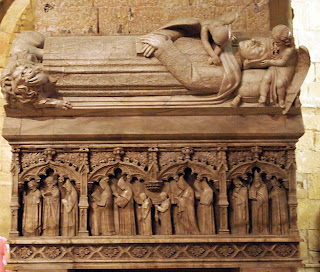Münzer at Poblet:
“The 29th of September, that was the feast of Saint Michael, having traveled three long leagues, we arrived at midday at the very noble monastery of Poblet. It is on a beautiful plain, in the foothills of some very high mountains. The monastery of Poblet is so magnificently built with so many and such grand palaces, patios, storerooms, cloisters, and with the wide wall that surrounds it, that you would believe it to be a castle. All the buildings are covered with cut squared stone, so strong that you would think that they were built against the passage of time. All is disposed for comfort and amenity.
I have never seen such a stronger or more beautiful monastery of that order. They are Cistercians of the order of Saint Bernard. There were then eighty monastic priests and forty converse or lay brothers. They keep a rigid observance. It was founded by the kings of Aragon, who have magnificent tombs there. There repose seven kings and their wives. The first of these was King Jaume, who obtained the royal scepter in the year of the Lord 1223, and maintained it during fifty-three years. He was a zealous persecutor of the Saracens in all of Spain. He defeated them on the island of Mallorca, in the realm of Valencia, the province of Murcia and many more. Finally, he adopted monastic habit, and making a celibate life, died with the Lord. He is buried there, in a splendid tomb of whitest marble. There also rests King Martin and the grandfather and the father of King Fernando, the actual monarch. I have never seen so many or such big casks as those of its storeroom. I counted sixteen of them. I think that thirty cartloads fit into each of them.
They have a very notable pharmacy, well provided with all kinds of medicines, a very hardworking doctor, with whom I spoke, finding him very knowledgeable. All the crafts and professions also have their rooms and offices dedicated to their work. Oh, how majestic is their church, constructed in the old style [Cistercian Romanesque]. As well as the chapels and the choir stalls, and their very beautiful organ, admirably decorated with gold and silver.
They treated us with great honor and courteously showed us each one of their precious objects."
What Münzer Saw:
Monasteries were heavily visited on Münzer’s journey because they had guest houses, and in places where any sort of stopping place was few and far between, they were trustworthy lodging places.
The paradox of Poblet is that it has virtually come around to what Münzer saw: Trashed in 1835, the place was left abandoned for a century. Perhaps because it was such a power symbol, Francisco Franco had it restored beginning in 1940, and since the basic structure of the church survived, it has mostly come down to us intact. Cistercian monks were established here once again, though now there are only 32 monks. And the resident lay community of artisans has vanished, but the way of life is virtually intact.
All the royal tombs that Münzer cites have been reestablished, though the images are recent and the ossuaries have mixed royal bones in them. We show some samples, with King Martin, the last king of the original Aragonese line, in the single tomb.
What Münzer Couldn’t Have Seen:
Aside from the souvenir shop, the monastery is making wine again, but now the concession is farmed out to the giant Codorniu firm. The monks now have their own comfortable cells with central heating and private bathrooms. (May 22, 2011)
Münzer on the Road to Valencia: I
“ September 30th, crossing very high mountains with valleys and gorges, traveling an entire day, we arrived finally at a Carthusian monastery, on a flat spot surrounded by mountains, that has the name of Scala Dei. It is a very venerable place and has religious monks. There were twenty-eight of them and three lay brothers. They received us affably, sharing with us what they had. There was a certain very learned young priest there, who was the son of a wise physician of Barcelona. He was sick with malarial fevers. With admirable gratitude he listened to my advice. May God grant him health! This monastery is very noble and beautiful.”
What Münzer saw:
Scala Dei or Escala Dei monastery is in a valley surrounded by high and impressive hills. The road there really was long and difficult. The monastery itself was at its first apex when Münzer was there, quite a bit smaller than Poblet. Since the 15th century, the monastery was expanded and redesigned in the 18th century, and then, like Poblet, destroyed in 1835. Unlike Poblet, the monks never came back, and over the next century and a half, many of its building materials were recycled by local farmers into their own structures. Most of the extant ruins date from the 18th century.
What Münzer Couldn’t Have Seen:
At present, the Catalan government is in the process of stabilizing the remaining ruins, and doing some intelligent reconstruction (a model of an 18th century cell and attached structures has been reconstructed), however the basic plan is to stabilize what remains. There’s a visitor’s center with an informative video.
The whole region, called the Priorat, has now become internationally famous for its wines, and so there are numerous tasting rooms. Münzer and his companions certainly drank the local wine, but what’s produced now is far more sophisticated!
Roads in the area are still extremely curvy, but still better than when 15th-century travelers journeyed here, and they needed an entire day to journey from Poblet to Scala Dei. In our car, it took about an hour. (May 22, 2011)








No comments:
Post a Comment